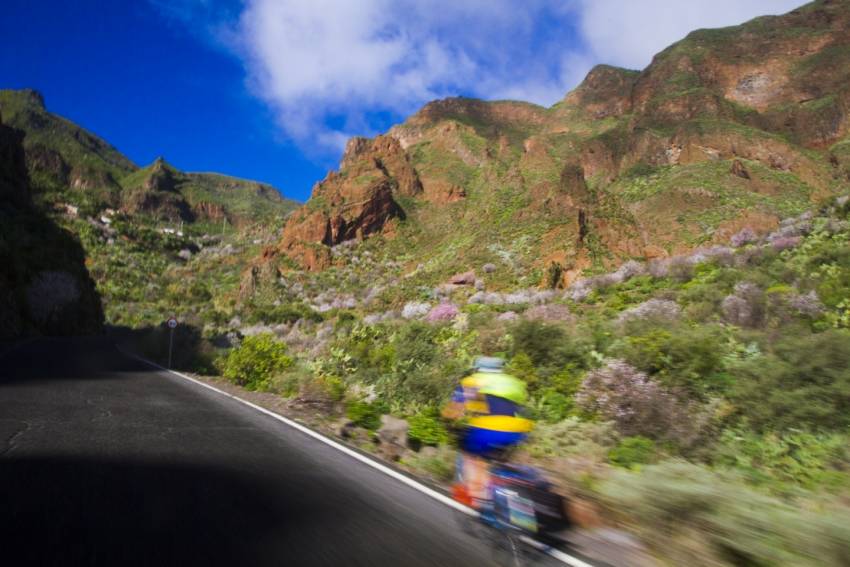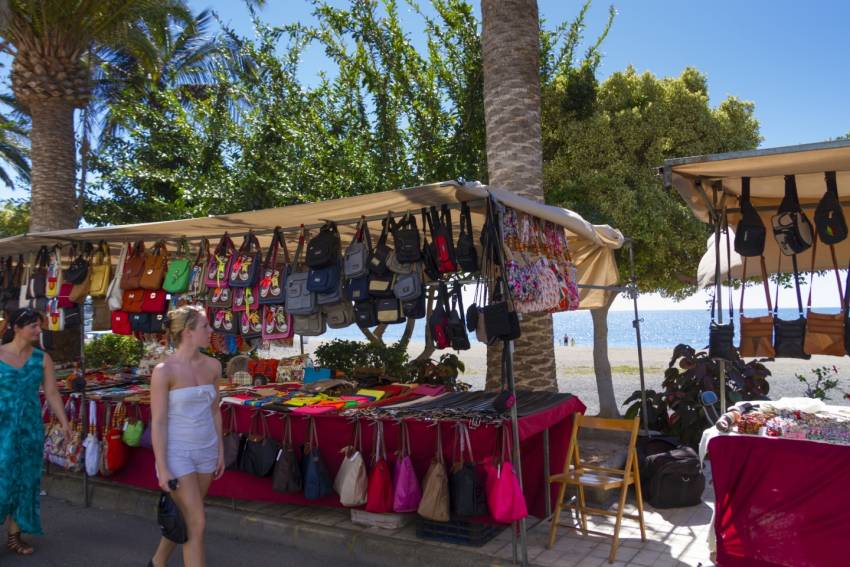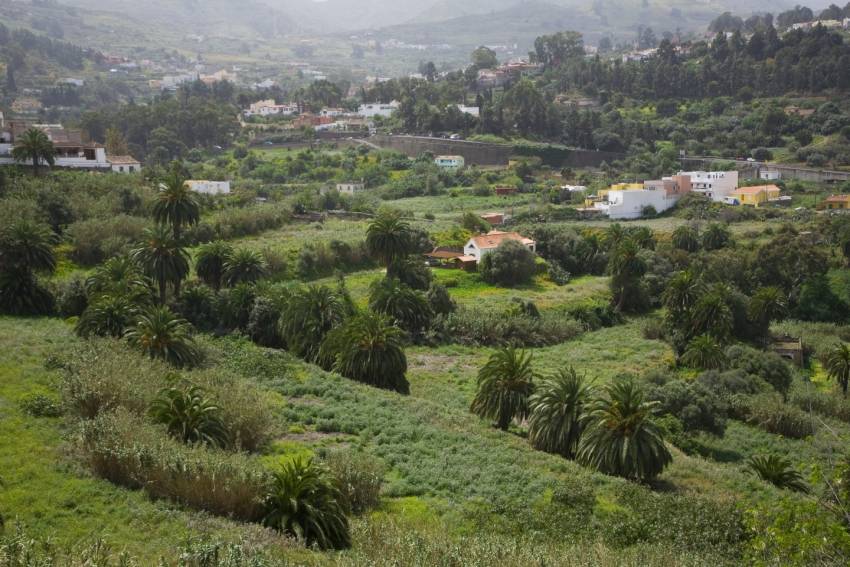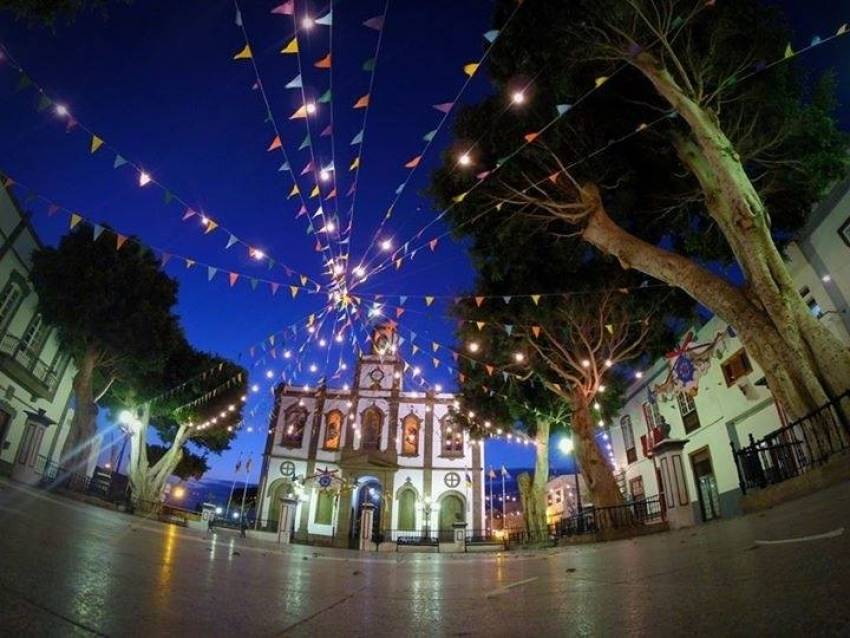Faneroque Beach: Gran Canaria's Least Visited Beach
Faneroque beach makes the more famous GüiGüi beach feel like Puerto Rico on a busy Sunday afternoon. If you make it, and few do, you'll have it all to yourself except for the rusty bulldozer.
Popular Pebbles At Puerto de las Nieves
Puerto de las Nieves in north-west Gran Canaria is more famous for its seafood than its beach. A shame, as few realise that the area gets some of the best weather on the island and that PDLN beach is a calm, sunny haven with fishing boats on the pebbles rather than sun loungers.
The Canary Islands Tree That Makes Rain
The Canary pine (pinus canariensis) is a miracle tree. Its needles make rain from the clouds and protect the tree from intense forest fires.
When the Trade Winds blow clouds and mist through the Gran Canaria pine forests the mist condenses on the long, droopy needles and falls as rain. This allows the pine forests to grow in areas with little rainfall, provided that they are high enough to get covered in cloud during the winter. The same long needles protect the trees from fires by burning fast before the heat damages the growing buds.
Canary pine grows all over the mountains of Cumbres of Gran Canaria, as well as on Tenerife, La Palma and El Hierro. It can reach 45 metres with a trunk at least 1.5 metres in diameter. The island's pine forests are home to a number of endangered animals and plants, including the Blue Chaffinch.
Gran Canaria's forests are recovering after centuries of over-exploitation and most of the forest you see was planted after the 1960s: Big old pine trees are rare as most were cut down for timber and charcoal.
Canary pine trees have lots of other uses: The seeds are edible, and a needle tea treats colds, coughs and bronchitis. Canary pine oil from the needles makes a powerful rub for arthritis and rheumatism, as well as being antiseptic. Canary pine wood is excellent for making furniture, but is no longer harvested.
The best way to see the Canary pine is to head up to Roque Nublo in the centre of the island. The whole surrounding area is covered with pine forest and there are plenty of walking tracks. Be careful with cigarettes, and never leave glass bottles behind, as the pine forests catch fire easily!
Aloe Vera: The Gran Canaria Cure For Sunburn
Gran Canaria's sun is African and in the summer it fries pale northern bodies in minutes. If you want a tan, take it easy for the first couple of days until your skin has a chance to adjust.
Arinaga: Gran Canaria's Most Improved Town
Arinaga's attractive promenade, a great natural swimming pool and decent seafront restaurants make it an excellent east coast lunch and swim stop. Just up the road is the world-famous El Cabron dive site and the unassuming but ecologically important Arinaga dunes reserve.
Agüimes Hill Town
The cobbled old town, with its vast church and squat, heat-proof Canarian houses is the prettiest example of a Gran Canaria hill town in east Gran Canaria. It's well worth a wander.
Caves, Bees And Blossom At Guayadeque Gorge
The Guayadeque gorge is easily the most interesting day trip in East Gran Canaria, especially combined with Aguimes old town and an afternoon swim at Arinaga. It's also a pain in the neck for visitors.
You'll get one from looking up at the high cliff walls and cave houses, then from ducking into the cave houses and chapel. Even the restaurant at the end of the road is carved into the rock.
The hum
Sound carries in the gorge and you'll hear dogs barking from their cave kennels and the shrill cry of kestrels as they harry the buzzards overhead. And then you'll notice the hum.
From their hives clustered high up on the valley sides Guayadeque's bees feast on a rolling buffet of flowers. The first course is a feast of pink and white almond blossom in January, followed by yellow broom, purple lavendar and blue bugloss flowers. There's always something in flower here: Guayadeque is one of the most biodiverse spots in Europe, home to dozens of unique Canarian plants.
Try the honey in the cave shops by the chapel half way up the valley.
Cavemen
Guayadeque was a stronghold for the island's original inhabitants. They were the valley's first troglodytes and their traces are everywhere. Visit the interpretation centre at the beginning of the valley road for details on their lives here and the traces they left behind.
Modern day locals still live in cave houses in the valley, although many have turned them into rural houses for visitors. In the old days it wasn't just the people that lived in cavesbut entire farms with everything from cows to rabbits dwelling inside the rocks.
Alex Says: Guayadeque is vertigo-sufferers gateway to the landscapes of central Gran Canaria. You get the monumental cliffs and rocks of the cumbres without steep drop offs.
Do I Need A VISA To Visit Gran Canaria?
This depends on your nationality.
No Visa is required (for tourists) for visits of up to 90 days if you are a citizen of ehe European Union, Norway, Iceland, Australia, New Zealand, Canada, Switzerland or the United States as well as several other countries.
If you are unsure, check with your Spanish Consulate/Embassy well before your flight day.
Your passport or identity card needs to be valid for a minimum of 3 months (and 6 months for certain countries).
Frequently Asked Questions - FAQ
Here's a growing list of FAQs that we get at Gran Canaria Info. If your question isn't here, then please ask us in an email or via a Facebook message. We'll answer ASAP.
Can I drink the Tap Water in Gran Canaria?
The island's tap water is perfectly safe to drink, wash in, cook with and brush your teeth with. It just doesn't taste too good as it's made from desalinated seawater. Nobody on the island drink the tap water unfiltered and most buy drinking water in five or eight litre bottles.
Are there cockroaches?
There
Can I get marmite, sausages, teabags?
What’s the weather
Which resort
airport transfers
Nightlife
Touts
San Mateo: Gran Canaria's Farming Town
You don't see many wellies in Gran Canaria but San Mateo, as the island's main farming town, is where they are concentrated. With rich soils and plenty of rain, it's main focus has always been agriculture rather than tourism. Despite a madcap plan for a cable car that doesn't look like changing anytime soon.
Gran Canaria Markets: Handicraft Monday in Puerto Mogan
Puerto Mogán massive Friday market is so crowded that there's now a Monday handicraft market in the town as well. This focuses on handmade goods and all stallholders have to be certified as local handicraft producers.
The Monday Mogán market is behind the beach rather than along the harbour wall. The goods on sale tend to be better quality than on Fridays but prices are also higher.
The San Lorenzo Farmer's Market
The weekend markets at Santa Brigida and San Mateo are so popular these days that there's traffic jams on the road up. Fortunatley there's a Sunday alternative close to Las Palmas that doesn't get the crowds.
San Lozenzo market has about 20 stalls and is a genuine farmer's market with all produce grown locally. It even has a price board at the entrance listing the maximum and minimum prices for the fruit and veg on sale.
One highlight of the San Lorenzo market is the cheese stall right at the entrance. All the cheeses on display are made in the surrounding area and tasting is encouraged. They even cut your cheese with a traditional Canarian knife. Their lightly smoked goat cheese is fantastic and the stall next door does a great flor cheese suitable for veggies.
As well as fresh produce San Lorenzo also has stall selling bread and local cakes as well as aloe vera products, Gran Canarian olive oil and local honey. There's a small cafe in the market square and another in the church square a couple of minutes walk away: It's only got six tables so be prepared to wait for a seat.
Get to San Lorenzo from Las Palmas by car (there is parking right next to the market), taxi or on bus 335. The market runs from 0.900 to 15.00 but quite a few stall sell out well before the end.
Gran Canaria Markets: Puerto Mogan's Massive Friday Market
Puerto Mogán on a Friday is the island's biggest outdoor market with stalls all along through the town and along the harbour wall.
There's hundreds of stalls selling everything from embroidery to fresh fruit and vegetables and you're bound to find something to take home. Combine it with lunch in the marina or a day on the beach and it's a great Gran Canaria day out.
We always recommend getting to the market early to avoid the crowds, especially if you drive and need parking.
A lot of people come by bus, but if you want to get the real holiday feeling why not take one of the glassbottom ferries from Arguineguín or Puerto Rico?
Gran Canaria Info Guide To Arguineguin Market
Arguineguín market is one of the big three in south Gran Canaria along with Mogán and San Fernando and fills the town every Tuesday morning. The stalls are all along the seafront on the cement factory side of town.
Most stall holders at Arguineguín also work the Puerto Mogán and San Fernando markets so there isn't much on sale that you only find at Arguineguín. That said, you can buy everything from silver jewelry to African baskets and it's a great day out. Look out for the smoothie stand at the south end of the market.
Getting to Arguineguin on a Tuesday is tricky if you leave it late as the buses and ferries are often full. Parking is a nightmare so consider hopping in a taxi rather than driving.
Avoid the crowded restaurants on the market side of town by heading back towards the beach for food. There's a string of restaurants facing the beach, including the excellent Taste Mesón.
Santa Brigida: Gran Canaria Hill Town With A Pretty Market
Santa Brigida town was used by the British as their summer Hill Station when they controlled the coal trade in Las Palmas port in the late 19th and early 20th Century. Nowadays it a quiet residential town with a great weekend market (and a great wine stall) and a couple of excellent restaurants.
Cliff Edge Views In Sleepy Moya
Moya has two claims for fame: Biscuits and a cliff-edge church square with a view of the deep Barranco behind the town. The view is spectacular, the biscuits not so much.
Moya church is a whitewashed Canarian church with stone edging in Neoclassical style. It's pretty but nothing more. However, it stands in a square right on the edge of the deep Barranco de Moya ravine. The view from the edge makes your tummy flip and is well worth a stop.
The town's famous bizcochos de Moya are much less exciting: Just dry biscuits with sugar on top that everyone in Gran Canaria has in the cupboard but nobody ever seems to eat.
Perhaps the real highlight of Moya is the walk around the Los Tilos de Moya laurel forest about five minutes drive from town. This is one of only two patches of laurels that survived the deforestation that followed colonisation and is one of the most biodiverse spots in Europe with dozens of rare Canarian plants. The circular walk takes you up the side of the valley and through the laurels.
Guia: Gran Canaria's Cheese Town
It says a lot about Guía that it's cheese is more famous than the actual town. It's pretty enough but a sleepy kind of place, especially compared with Galder next door.
Santa Maria de Guía's church square and the cobbled streets running off it have their charm. The problem with Guía from a vistor's point of view is that there isn't much do there except for look at it. The Sunday market in the square only has five stalls: It's the place to go to get great Flor de Guia cheese right at source but doesn't sell much else.
Flower cheese
Flor de Guía is a soft, creamy and slightly bitter goat and sheep cheese with a faint odour of socks. It comes in wheels only a few inches thick and tends to sag with age. It's great stuff and is made with cardoon flower sap rather than rennet, making it the only local cheese suitable for veggies.
Cheese festival
Guía perks up during the annual Fiesta de Queso (cheese festival) in April/ May. It's the time to visit with lots of cheese and food stalls and general celebrations of anything cheesy.
If you're in Guía outside fiesta time, head to La Quesera organic cafe for a great selection of local cheese and wine. It's in a 19th Century house and chapel and has an organic garden in its courtyard. The address is Calle Pérez Galdós 27.
God and Garlic Sausage In Teror
Teror is on all the lists of places you have to see in Gran Canaria and is one of the island's prettiest towns with lovely cobbled streets and wooden balconies. That said, the religious angle overwhelms all others in Teror, apart from the pungent sausage.
Agaete: Gran Canaria's White Town
"Come and visit, look around, then go away". Agaete's unofficial motto isn't exactly tourist board stuff but then this is a town that marches to the beat of its own drum. While most Canarian towns are much of a muchness, here's a few ways that Agaete stands out:
- It grows Europe's only coffee crop
- It's the island's most musical town but it's best musicians don't play local folkloric stuff
- It has Spain's highest unemployment rate but doesn't have a sign welcoming tourists
- It hosts the island's biggest party but is quiet the rest of the year
Sunken gardens, hidden graves, etc
Almost everything that makes Agaete such an interesting town is hidden from plain sight. The entrance to the gorgeous Huerto de las Flores sunken garden is down a lane, round the corner and through an arch, while caveman necropolis just outside the town is hidden on a lava flow.. The music scene only starts in the evenings once most visitors have driven back to their resort.
Do a 2,5h tour in english with a young inspiring and enthusiastic local, learn all about this beautiful village and pay as much as you like. Good deal? We certainly think so!
Yearly blow out
The annual Bajada de la Rama fiesta in Agaete is epic with almost 100,000 Canarians invading the town for a whole weekend. It's good natured bedlam and the procession, with thousands of green branches and giant papaguevo papier mache figures, is the island's best.
The valley of longevity
The deep Agaete Valley, the most fertile on the island, cleaves it's way to the sea from the high Tamadaba massif. The valley's inhabitants swear that drinking it straight from the rock springs brings good health and longevity. Filtered by pine forests and kilometres of rock it's certainly makes the plants grow. There more variety of tropical fruits and flowers here than anywhere else in the Canary Islands.
The other Gran Canaria
The Agaete Valley is where Gran Canaria's other tourists go: The walkers and winter visitors who wouldn't be seen dead in a resort but still want the island's great weather. As a rural tourist destination is has everything: Traditional houses, great walks, a quiet town full of character, a seaside enclave and even the island's highest rock climb.
We think the Agaete Valley is the island's most comple rural tourism destination and the place to go if you want to experience local life and still get a tan.
Whitewash, Fish And Pebbles At Puerto De Las Nieves
Puerto de Las Nieves is the prettiest coastal village in Gran Canaria and while its iconic rock lost its finger in 2005 the village still has its fishy charm. The houses are all whitewashed, the window frames blue, and the beachfront restaurants serve local fish.
And it's sunny: The area has its own microclimate and gets almost as much sunshine as the southern resorts. Even when the whole of the north coast is cloudy, Puerto de las Nieves and Agaete get blue skies.
Things to do and see
Other than eat, swim and relax there's not much (and that's why we love it):
With the locals cramming in at the weekends for a weekend seafood feast, it's best to visit during the week when things are calmer.
Puerto de Las Nieves’ iconic Dedo de Dios (Finger of God) rock sadly lost its finger during a storm a few years ago. You can see the knuckle by looking left from the end of the jetty.
The natural swimming pools, with lava arches and plenty of space to sunbathe, are a great sunset spot.
The famous set of Dutch paintings that give the town its name are in the church, but it's permanently locked.
Most restaurants close in the evening and the nearest bars are in Agaete just inland.
The Agaete Valley behind the town is one of the prettiest in Gran Canaria and is full of traditional houses, palm trees and coffee. The road up ends at the top so you have to drive back the way you came.
Adventurous drivers head from Agaete along the west coast on the spectacular, cliff-edge road to La Aldea de San Nicolas. It’s windy and the drop offs extreme. For those with vertigo, it’s a no-no.
There're several natural, nudist beaches within walking distance.
Beaches
From the town walk up the hill to Turman (a housing estate on the little hill behind the town). Here, a dirt path runs to La Caleta Bay with its pebble beach and rock shelves. There's a set of convenient steps running down to La Caleta. It takes ten minutes to walk from the town up to Turman, and another 15 to get to La Caleta.
El Juncal is another 40 minutes walk past Caleta: It’s a pretty valley with a bigger pebble beach at its mouth. Juncal is clothing optional and often empty as the only way in is on foot or with a four-wheel drive. The walk is pretty dusty, but you get some great views of the coast and the spectacular west coast cliffs. Take food and water as there are no facilities at all at El Juncal. The water is crystal clear and the snorkelling is excellent.
Further away, to the south, is Guayedra Beach: A firm favourite for locals and people from the nearby town of Galdar. The walk from Puerto de Las Nieves has some steep drop-offs and takes about an hour-and-a-half. The beach is mixed sand and pebbles (no facilities) and mostly nudist.
Food
Most restaurants have outdoor terraces with views of the beaches. Until recently they all did seafood stapes like fried fish, calamares, sardines, etc. Now there's a couple of Italian options as well.
Always ask for an ensalada mixta as the Puerto de Las Nieves version always comes with tropical fruit along with the standard Canarian salad ingredients (lettuce, tomato, cucumber, red onion, tuna, asparagus, corn, etc). Order a salad for half the number of people at the table.
The Las Nasas restaurant is the most famous restaurant in town because of its lovely terrace. Arrive at 13.00 at weekends for a guaranteed terrace table. A
The Dedo de Dios restaurant (left of the stone jetty) doesn’t have outside terrace space but is cheap and does huge portions of very reasonable food. It even opens at night.
Gran Canaria Info recommends:
- Default
- Title
- Date
- Random





























